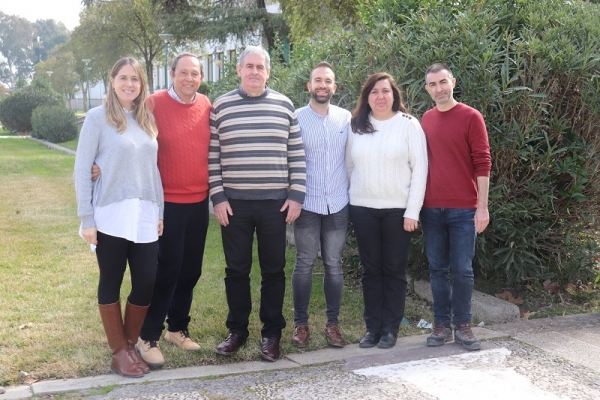Marine cyanobacteria are the most abundant photosynthetic organisms on Earth, and are responsible for producing a large portion of the oxygen we breathe. Although their main source of energy is through photosynthesis, a process by which they convert CO2 from the atmosphere into organic matter, depending on certain circumstances they are also able to directly capture organic substances from the environment, such as glucose, and assimilate them as a source of energy. This is why they are considered mixotrophic organisms, as they have a hybrid way of feeding (light, and organic matter).
With the aim of understanding the certain circumstances that allow cyanobacteria to directly capture organic substances, a research group at the UCO, Adaptations in the Metabolism of Nitrogen and Carbon in Marine Cyanobacteria, has carried out several studies shedding light on how these organisms assimilate and take advantage of glucose, which is the most abundant organic compound in nature.
In a study published in the journal Microbiology Spectrum, the team found that the ability to capture glucose and its effects on metabolism are different between different strains of Prochlorococcus and Synechococcus, which are the two main genera of cyanobacteria. That is, there are some cyanobacteria that are more effective at capturing glucose, and the use they make of it may also be different, since "marine cyanobacteria in the ocean are able to modulate their metabolism depending on the availability of glucose," explained José Manuel García Fernández, a member of the research group.
Now, one thing is the assimilation of glucose (that is, how they use this organic matter), and another is how they manage to capture it. For this, they use proteins called transporters. These proteins identify glucose in the environment and introduce it into the cell. In an article published in BBA Bioenergetics, in collaboration with the Universidade Nova de Lisboa, the team was able to accurately identify the structure and functions of the Prochlorococcus glucose transporter, which stands out for being able to identify small amounts of glucose around it. "Future studies," explains García Fernández, "will allow us to answer the question of which specific parts of this transporter are responsible for having that capacity."
In addition, in research conducted in collaboration with the University of Hawaii and the University of Arizona, published in Microbiology Spectrum, in which they analyzed natural samples during an oceanographic campaign in Hawaii, the team has added three more characteristics to the relationship between Prochlorococcus and glucose. First, they found that glucose transport is greater during the day than during the night thanks to the availability of light. Second, glucose uptake follows a different circadian cycle than that of other bacteria living in the same area of the ocean. Finally, the team discovered differences in glucose metabolism between surface and at-depth cyanobacteria.
This whole process of glucose assimilation is fundamental for some cyanobacteria, and generates advantages over their competition: they save energy (since it takes a greater effort to transform CO2 into organic matter than to feed directly on it) and take organic matter from other competing microorganisms around them. And, although the main energy source of cyanobacteria is sunlight, many live in deep areas where no light reaches, so it is essential for them to capture organic matter to survive. This has been demonstrated recently by researchers at the University of Haifa (Israel), in an article that UCO professor María del Carmen Muñoz Marín reviewed for Nature Microbiology.
References:
José Ángel Moreno-Cabezuelo, Guadalupe Gómez-Baena, Jesús Díez, José Manuel García-Fernández, "Integrated Proteomic and Metabolomic Analyses Show Differential Effects of Glucose Availability in Marine Synechococcus and Prochlorococcus", Microbiology Spectrum, vol. 0, 2023, https://doi.org/10.1128/spectrum.03275-22.
José Ángel Moreno-Cabezuelo, María del Carmen Muñoz-Marín, Antonio López-Lozano, Diogo Athayde, Ana Simón-García, Jesús Díez, Margarida Archer, Federico M. Issoglio, José Manuel García-Fernández, "Production, homology modeling and mutagenesis studies on GlcH glucose transporter from Prochlorococcus sp. strain SS120", Biochimica et Biophysica Acta (BBA) - Bioenergetics, vol. 1864 (2), 2023, https://doi.org/10.1016/j.bbabio.2022.148954.
María del Carmen Muñoz-Marín, Solange Duhamel, Karin M. Björkman, Jonathan D. Magasin, Jesús Díez, David M. Karl, José M. García-Fernández and Adriana Lopes dos Santos, "Differential Timing for Glucose Assimilation in Prochlorococcus and Coexistent Microbial Populations in the North Pacific Subtropical Gyre", Microbiology Spectrum, vol. 10 (5), 2022, https://doi.org/10.1128/spectrum.02466-22.
María del Carmen Muñoz-Marín, "Mixotrophy in depth", Nature Microbiology, vol. 7, 1949–1950, 2022, https://doi.org/10.1038/s41564-022-01251-4.


